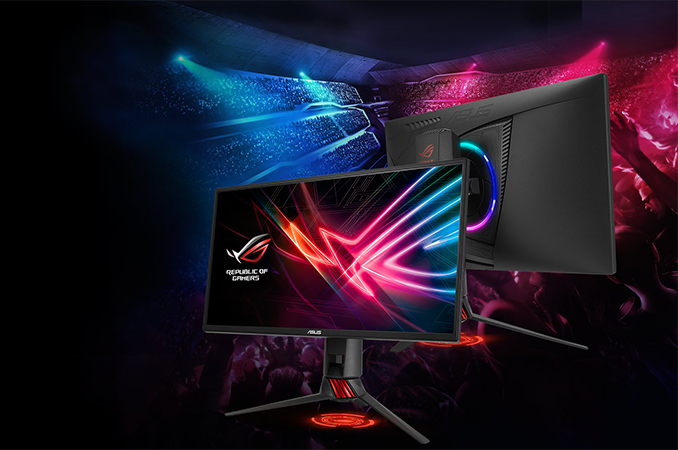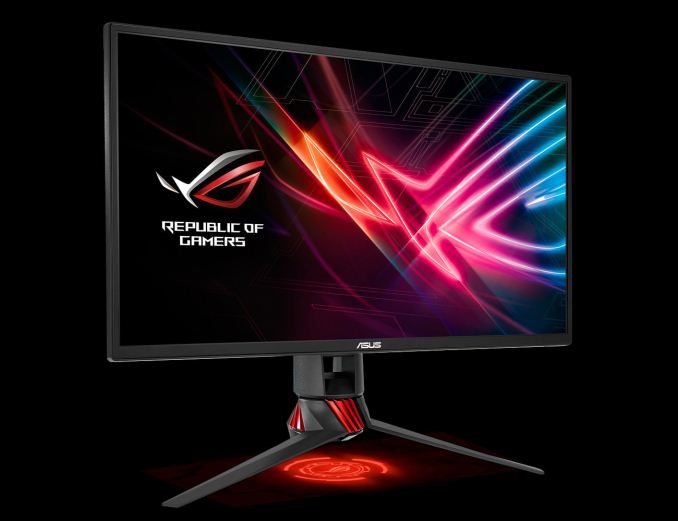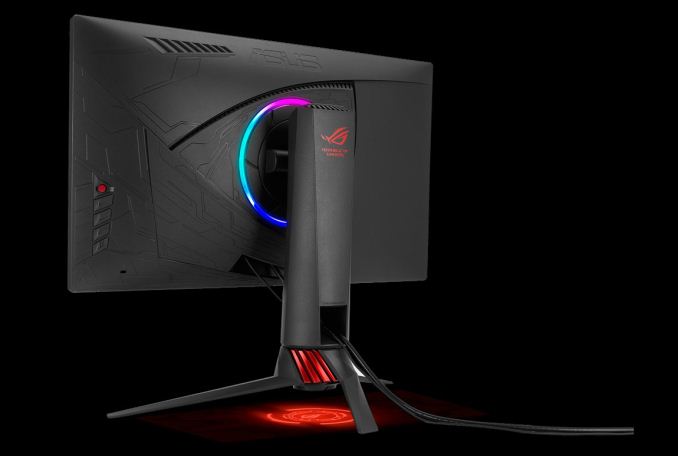ASUS Ships ROG Strix XG258Q ‘eSports’ LCD: 1080p 240 Hz Display w/FreeSync
by Anton Shilov on November 27, 2017 10:00 AM EST
ASUS has added a new ultra-fast monitor forhardcore gamers and eSports enthusiasts to its lineup. The new ROG Strix XG258Q resembles its close relative — the ROG Swift PG258Q — when it comes to key characteristics such as FHD resolution and 240 Hz refresh rate. However whereas the PG258Q is a G-Sync monitor, the new XG258Q uses AMD’s FreeSync instead. Along with the variable refresh features, the new monitor also features ELMB (extreme low motion blur) tech as well as ASUS’ Aura RGB lighting effects on the back.
The ASUS ROG Strix XG258Q is based on a 24.5” TN panel from AU Optronics with a FHD 1920×1080 resolution and a 16:9 aspect ratio. Since the display is aimed primarily at professional gamers, its main features are 1 ms GtG response time as well as a 240 Hz refresh rate. To make gameplay smoother, the XG258Q supports AMD’s FreeSync dynamic refresh technology that can work in the range between 48 and 240 Hz over either a DP 1.2 or HDMI 2.0 connection. Furthermore, ASUS equipped the monitor with its Extreme Low Motion Blur (ELMB) technology that promises to make fast-paced actions look sharper. ASUS first presented their ELMB/ULMB implementation several months ago, but still has not described how their variant of the tech works, and if it differs at all from typical ULMB backlight strobing.
The ither specifications of the ROG Strix XG258Q are typical for a fast modern TN-based monitor. The unit can display 16.7 million (6-bit + FRC) colors, has a typical contrast ratio for mainstream screens (1000:1), features 170°/160° viewing angles as well as offers a 400 cd/m2 brightness, which is bit higher compared to average monitors. As for connectivity, the new monitor can use HDMI 1.4 (but only for refresh rates up to 140 Hz), HDMI 2.0, or DisplayPort 1.2. As for ergonomics, the ROG Strix XG258Q can adjust height, tilt, swivel or can be attached to a VESA wall mounting.
Since we are dealing with an ROG monitor here, it is not surprising that the unit comes with a host of ASUS proprietary enhancements for gaming displays, including GamePlus OSD features, GameVisual modes that adjust for particular game genres and so on. In addition, to make the monitor look like all the latest gaming devices from ASUS and stand out from the other gaming LCDs, the XG258Q has the company’s customizable ROG signature projection on the bottom as well as the Aura RGB LEDs on the back.
| ASUS ROG 24" Displays with a 240 Hz Refresh Rate | |||
| ROG Strix XG258Q | ROG Swift PG258Q | ||
| Panel | 24.5" TN | ||
| Native Resolution | 1920 × 1080 | ||
| Refresh Rate | 240 Hz | ||
| Dynamic Refresh Rate | Technology | AMD FreeSync w/LFC | NVIDIA G-Sync |
| Range | 48 - 120 Hz for HDMI 1.4 48 - 240 Hz for HDMI 2.0, DP 1.2 |
30 - 240 Hz for DP 1.2 | |
| Response Time | 1 ms (gray-to-gray) | ||
| Brightness | 400 cd/m² | ||
| Contrast | 1000:1 | ||
| Viewing Angles | 170°/160° horizontal/vertical | ||
| Inputs | 1 × HDMI 1.4 1 × HDMI 2.0 1 × DisplayPort 1.2 |
1 × HDMI 1.4 1 × DisplayPort 1.2 |
|
| USB Hub | - | 2 × USB 3.0 | |
| Proprietary Enhancements | ELMB Trace Free Technology Color Temperature Selection: 4 Modes GamePlus Modes: Crosshair/Timer/Display Alignment Low Blue Light: Yes VividPixel: Yes GameVisual Modes: Scenery/Racing/Cinema/RTS/RPG/FPS/MOBA/sRGB |
ULMB Trace Free Technology Color Temperature Selection: 4 Modes GamePlus Modes: Crosshair/Timer/Display Alignment Low Blue Light: Yes GameVisual Modes: Scenery/Racing/Cinema/RTS/RPG/FPS/sRGB |
|
| Power Consumption |
Idle | ~0.5 W | |
| Active | 65 W at 200 cd/m² | ||
| Detailed Information | Link | Link | |
The ASUS ROG Strix XG258Q is already available for $449, which is over $50 cheaper than the current market price of the ROG Swift PG258Q featuring NVIDIA’s G-Sync.
Related Reading:
- BenQ Announces ZOWIE XL2546 ‘eSports’ Display: 24'', FHD, 240 Hz, DyAc ULMB Tech
- ASUS Launches ROG Swift PG27VQ: Curved 27-inch LCD with 165 Hz G-Sync & RGB Lighting
- ASUS ROG Strix XG27VQ Available: 27” Curved, FHD@144Hz & FreeSync w/ELMB
- ASUS Demonstrates ROG Swift PG27UQ: 4K, 144 Hz, HDR, DCI-P3 and G-Sync
- ASUS Adds Entry-Level VP28UQG to Gaming LCD Lineup: 28”, 4K, FreeSync, 1ms
- AOC Launches the AG352QCX: 35-Inch 200 Hz 2560×1080 Curved Display with Adaptive-Sync
Source: ASUS


















21 Comments
View All Comments
xchaotic - Monday, November 27, 2017 - link
$449 for a 24" TN 1080p panel, what a bargain....JoeyJoJo123 - Monday, November 27, 2017 - link
Wow, nice attempt to sweep the monitor's other big features such as 240hz, Freesync, and ELMB modes under the rug.Next you'll complain that Mazda had the audacity to sell a 1.2L engine sports car for $50K, but completely fail to mention that it's turbocharged and a rotary engine, which allows it to pull similar horsepower/torque numbers as competitors, at a fraction of the curb weight.
shabby - Monday, November 27, 2017 - link
Horrible comparison with the rx7.JoeyJoJo123 - Monday, November 27, 2017 - link
Would you rather a food analogy be made?The case in point is that pointing out one spec as being "bad" in a vacuum isn't inherently a good argument since it's being taken out of context of every other performance metric associated with that product. That's why I made the RX-7 analogy. In a vacuum, you might say 1.2L engines offer poor power, but taken in context that a rotary engine is in use, along with turbocharging, the final performance metrics matter a lot more than one cherry picked thing that someone didn't happen to like.
Complain that it's TN sure, but it's 240hz (not seen on IPS beyond 165hz and only though display overclocking), and has additional Freesync and ELMB features which add to the performance of the monitor in question.
The only inherently poor thing about TN is that it washes colors out at an angle, particularly when viewed from the bottom, which doesn't particularly matter for fixed location desktop users, as your keyboard and mouse and desk will all be used from a fixed viewing position anyways.
>But IPS has better colors!!
Yes, when the display manufacturer either chooses a 10-bit addressable panel, or specifically tunes the monitor to be designer/creative work oriented. The high refresh rate IPS panels are 8-bit don't have a color gamut that's any higher than high refresh TN panels.
The current pick-your-poison for high refresh rate panels is that you either go TN and color washes out when you're trying to view your monitor away from your desk position or you go IPS and suffer from extra-terrible backlight bleeding (which has affected every single 144hz+ IPS panel on the market to date, but in particular the Asus model(s) such as the PG279Q which have a poor seal on the thin bezels). Both TN and IPS models can be color calibrated to standard sRGB color space equivalently well (~98%+), but the fact of the matter is that when you're looking at the monitor straight on, the TN panel variations don't suffer from backlight bleeding whereas you're playing monitor roulette for any IPS panel variant and hope the backlight bleeding you get is less severe than others.
Sivar - Monday, November 27, 2017 - link
It's always refreshing to read a comment and feel like my understanding of the universe is that much better.I thought I was pretty well-versed in display tech, but you, sir, added significantly to my understanding today. Thank you.
Death666Angel - Monday, November 27, 2017 - link
Well, don't confuse backlight bleed with IPS glow. Color gamut is much more a function of the backlight used (CCFL, wLEDs, RBG LEDs) and the bitrate of the panel, not of the actual panel technology, that's right.I have to disagree with you assessment of IPS vs TN to some degree though. My old 24" 1920x1200 TN monitor (HP w2408h I think) had a noticeable color/contrast shift when looking straight ahead from a normal viewing distance (~50cm) between the top and bottom. That is what is keeping me away from TN panels at that size. IPS displays have their issues as well, but the only thing that is inherent in the technology is IPS glow and slower pixel response. BLB is an QC issue, not an IPS issue, so it isn't a plus for TN panels either, like you make it sound.
JoeyJoJo123 - Monday, November 27, 2017 - link
When I say backlight bleed, I am specifically referring to this:https://www.google.com/search?tbm=isch&q=backl...
Where you can look at a monitor, dead center, and notice that a dark color (easily seen with pure black) shows a variety of clouding of other colors, typically at the corners. It essentially means that there is extreme variance in the color output produced by the monitor due various areas being brighter than the other.
IPS Glow is just a whitening/halo-like glow of the image when seeing particularly dark scenes off center. IPS Glow is just part of the IPS panel package, and there's nothing really escaping that trait. Just as when seeing TN panels there's distinct color shift off-axis. IPS glow is traditionally seen as more favorable than otherwise having TN color-shifting.
The problem is that the sheer majority of the high refresh rate panels we're seeing are being manufactured by one panel company: AU Optronics. AU Optronics' TN panels and their correlated monitors manufactured by partners haven't suffered the same degree of backlight bleeding that their IPS panel variants have. This isn't a problem unique to the PG279Q (https://www.youtube.com/watch?v=mje_fmayu0k) even though THAT specific model has gotten a lot of coverage. This ALSO happens commonly to monitors like the Acer XB271HU using the exact same panel, although to lesser degree since they have a better seal on the panel and backlight.
> have to disagree with you assessment of IPS vs TN to some degree though. My old 24" 1920x1200 TN monitor (HP w2408h I think) had a noticeable color/contrast shift when looking straight ahead from a normal viewing distance (~50cm) between the top and bottom.
And I wouldn't disagree with you there, many old TN monitors were pretty bad. But you should take a step outside, walk into a Best Buy or other computer electronics store and take a look at current, modern high-refresh rate TN panels like the Dell S2716DG. They're surprisingly not as poor in regards to color shifting as older TNs, and the contrast and color space looks just adequate for sRGB content. It's no 10 or 12-bit RGB LED backlit designer monitor, nor is it OLED, but for standard sRGB content at a ~1:1000 contrast ratio, it looks very comparable to a similar sRGB 1:1000 contrast ratio IPS, outside of color shifting at extreme angles.
So when you are on the market for 144hz monitors, it's literally a question of whether you're picking something that will generally have next to no backlight bleed but suffers from some amount of color shift (TN). OR a monitor that you're playing roulette for varying degrees of backlight bleed, but fare much better towards color shifting (IPS). If you're going to be using exclusively from your desktop, it's pretty logical to favor the TN, given all the other metrics are relatively equal.
Until Sharp, LG, or Samsung, or AU Optronics start developing alternative high refresh rate IPS panels, this is the reality of the current high-refresh rate IPS vs TN monitor market right now. I'd love to be wrong about this. I'd love for there to be a 120hz 4K IPS monitor with inky blacks from backlight zones to exist right now, but that's not where we are quite yet.
saratoga4 - Monday, November 27, 2017 - link
>Yes, when the display manufacturer either chooses a 10-bit addressable panel, or specifically tunes the monitor to be designer/creative work oriented. The high refresh rate IPS panels are 8-bit don't have a color gamut that's any higher than high refresh TN panels.Problem with calibrating a TN panel is that the color depends on angle, so unless you look at the same angle as your calibrator (which does not necessarily have angular acceptance as your eyes), your calibration will be off.
shabby - Monday, November 27, 2017 - link
Just stop talking about the rx7, no one said its engine makes poor power. The rx7's engine is basically a 2.6L because it has 1 power stroke per revolution compared to a regular engine having 1 power stroke every two revolutions.100hp per liter was the norm for almost every turbo charged 90's import engine, so 255hp from basically a 2.6L was not poor.
JoeyJoJo123 - Tuesday, November 28, 2017 - link
"no one said its engine makes poor power"Maybe one day you'll learn to read and stop taking a comment out of context. Please re-read:
>In a vacuum, you might say 1.2L engines offer poor power, but taken in context that a rotary engine is in use, along with turbocharging, the final performance metrics matter a lot more than one cherry picked thing that someone didn't happen to like.